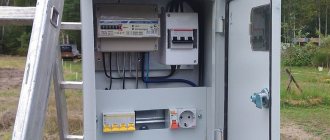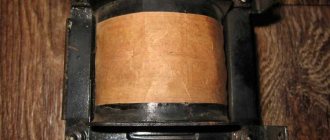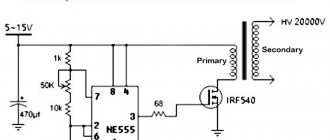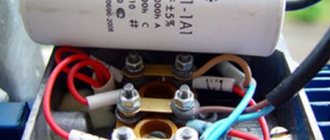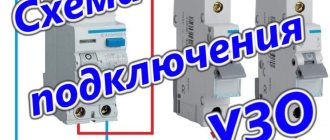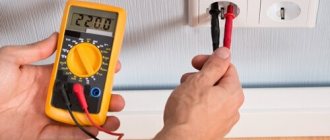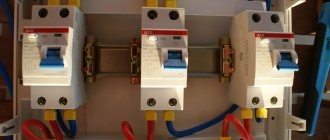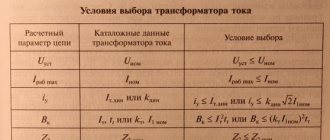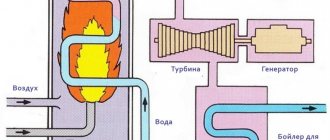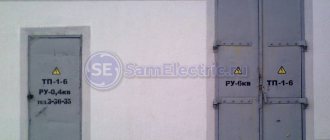Almost all household electrical appliances are designed for a voltage of 220 V. We, without hesitation, plug them into the outlet and enjoy the operation of the devices. But sometimes you need to connect an asynchronous motor designed for 380 V. To start it, you can use a special circuit that allows you to connect the electric motor to a single-phase network, but you will have to put up with a loss of power. Is it possible to turn a single-phase network into a three-phase one and how to make 380 from 220 Volts?
It turns out there is such a possibility. There are several ways to get 380V from a single-phase network. Below we will show how to do this, but first we will understand how a single-phase network differs from a three-phase one.
Theory
At industrial power plants, generators generate three-phase current and increase its voltage to tens and even hundreds of kilovolts. Electricity is supplied to consumers through power lines. But before this, the current enters the power transformer, which lowers the voltage to 380 V. From the distribution substation, the electricity enters the consumer network.
In a three-phase network, the current is supplied in such a way that all three are shifted relative to each other by 120 degrees. The voltage between phases is 380 V, and between phase and neutral 220 V (see Fig. 1). It is this voltage that is supplied to each apartment.
Rice. 1. Three-phase current structure
Since our goal is to obtain 380 V from a single-phase network, we will move on to methods of converting 220 V to 380.
What is the difference between a single-phase and three-phase generator?
Single phase generators
Single phase generators
are used to power only single-phase devices and equipment that require a voltage of 220 Volts for their operation. These are just all the household appliances and tools that surround us in everyday life. The dashboard of such generators has one or more 220-volt outlets.
All single-phase generators are equipped with 220 Volt / 16A sockets, which are used to connect common appliances. Some generators are equipped with 220 Volt / 32A power outlets for connecting powerful consumers (see photo).
In the vast majority of cases, a single-phase generator will suit you for domestic use (if you do not plan to connect any three-phase consumers).
Three-phase generators
Three-phase generators
can be used to power both three-phase, with a supply voltage of 380 Volts, and single-phase devices and equipment. On the dashboard of such generators there are sockets for both 380 Volts and 220 Volts (see photo). Such electric generators are used very widely for industrial purposes, in factories, on construction sites, etc.
Methods for obtaining 380 Volts from 220
Let's look at the main ways to convert 220 volts into full three-phase current, 380 V:
- using an electronic voltage converter;
- by using a transformer;
- using three phases;
- using a three-phase motor as a generator;
- using a capacitor circuit.
Voltage transformer
The easiest and most reliable way to convert 220 V to 380 is to buy an electronic voltage converter. (see Fig. 2). This device is often called an inverter. The gadget is easy to operate and generates high-quality three-phase current. True, the power of inverters is not very large, but, as a rule, it is enough for most three-phase household appliances.
Rice. 2. Voltage converter
The converter is also good because it has a built-in overload and short circuit protection function. This means that the electric motor will not overheat and will not fail as a result of a short circuit.
High quality current is achieved thanks to the operating principle of the device. The inverter first rectifies single-phase alternating current and then generates three-phase voltage at a given frequency and with a standard phase shift. In this case, the number of phases can be more than 3 (with a corresponding shift angle).
Using a transformer
Using a step-up transformer, you can get any voltage, including 380 V. However, if you are interested in three-phase voltage, then you need a special three-phase transformer. converting single-phase current into three-phase. Such transformers are commercially available.
The transformer windings are connected in star or delta. Single-phase network voltage is supplied to two primary windings directly, and to the third through a capacitor. In this case, the capacitor capacity is selected at the rate of 7 μF for every 100 W of power.
Please note that the rated voltage of the capacitor should not be lower than 400 V. Such a device cannot be turned on without a load.
Although we will obtain the necessary 380 V in this way, there will still be a decrease in the power of the electric motor (if you plan to connect it to a transformer). Accordingly, the engine efficiency will also drop.
Using 3 phases
If you live in an apartment building, then 3 phases are already connected to it, which, in order to optimally distribute the loads, are separated into individual apartments. On each floor there are distribution boards, from where you can bring the missing two phases into the apartment. But this will require permission.
If you wish, you can obtain permission from the energy supply company or coordinate with Energonadzor the installation of three-phase power in your apartment. In this case, you will need to install a three-phase electricity meter.
Using an electric motor
You probably know that the rotor of a conventional three-phase motor, after starting, continues to rotate after one phase is disconnected. It turns out that there is an EMF between the terminal of the disconnected winding and the activated terminals.
The phase shift between the stator windings depends only on their location. In a three-phase motor, these coils are located at an angle of 120º, which means they provide the same phase shift angle. This circumstance suggests that an asynchronous three-phase motor can be used to obtain 380 volts from a conventional single-phase network. A simple diagram for connecting an electric motor is shown in Figure 3. The capacitor in the diagram is needed only to start the engine. Once launched, you can disable it. We take the capacitor type MBGO, MBGP, MBGT or K42-4, the operating voltage of which must be at least 600 V. You can use the capacitor K42-19, with an operating voltage of at least 250 V.
For an example of connecting a phase-shifting capacitor, see Fig. 3.
Rice. 3. Connecting the starting capacitor
We select the parameters of the capacitor depending on the power of the motor. Note that the parameters of the phase-shifting capacitor do not affect the quality of the generated current. We connect the load to the stator windings according to the diagram shown in Fig. 4.
Rice. 4. Three-phase current from an electric motor
The rotor rotation speed is almost independent of the single-phase network voltage, so it can be considered constant. This means that the frequency of three-phase current at rated loads will not change.
It should be borne in mind that the power of a three-phase motor operating from a single-phase network decreases. Accordingly, the rated power of a three-phase load will be approximately one third lower than that stated in the electric motor’s passport.
Electric motor as generator
Another way to get 380 from 220 V is to create a motor-generator system. As a motor, you can take any electric motor operating from a 220 V network, and as a generator, you can take a modified three-phase asynchronous motor (see Fig. 5 for the installation diagram).
Let us immediately note that the effectiveness of such an installation is questionable, but it is possible to obtain the required voltage of 380 V in this way. In this circuit, it is necessary to ensure such a rotor speed that the generator produces current with a frequency of 50 Hz. To do this, it is necessary to rotate the shaft at an angular speed of 1500 rpm.
Rice. 5. Three-phase motor as generator
At home, you can use a single-phase motor from a washing machine or other household appliances as a drive. It is only important to ensure the required angular speed of rotation of the rotor.
Since the rotation of the shaft of electric motors operating, for example, in a washing machine is about 12 - 20 thousand rpm, it is necessary to use pulleys whose diameters have a ratio of 1 to 10. That is, to ensure rotation of the generator rotor at a speed of 1500 rpm min. you can take a pulley that is already mounted on an electric motor from a straightening machine, and put a pulley with a diameter 10 times larger on the shaft of a three-phase motor.
Comments:
And I thought that the three-pole one is connected as phase-zero-ground, but it turns out to be like this... Live and learn! Can it be used in a panel for a single-phase network, if three circuits need to be disconnected at once?
Evgen, why is it needed then? Power all three phases through a single-pole switch and they will turn off at the same time without any problems! And you'll save space on the rack.
Why can't you use a three-pole switch in a single-phase network? Disconnect phase, neutral and ground at the same time? If you place it, for example, at the input to the panel. It seems to me that this is more correct.
Denis, why do you need to disconnect the ground at the input? A three-pole switch is only
in a three-phase network, but using it in a single-phase network is possible, but impractical. Just as impractical as disconnecting the ground in the example you gave
Sometimes it’s useful to turn off the zero - when there is a phase imbalance, in villages all the time. But you need to tear up the ground ONLY if there is a split trans, and AFTER it.
Virtual Private Servers
One of the most prominent, in the literal sense of the word, characteristics of a circuit breaker is the characteristic that determines the number of poles of the circuit breaker.
and if you need to disconnect two phases and three-pole zero will work
Leave a comment Cancel reply
Fuel-free generator - a way to make money on illiteracy
Pros and cons of vertical wind generators, their types and features
Windmill for a private home - a toy or a real alternative
Power bank with solar battery - calculation for illiteracy
How to choose a solar panel - overview of important parameters
conclusions
It is possible to obtain 380 volts from a 220 V network in several ways. The most effective way to use an electronic inverter is:
- stable current parameters;
- safe operation;
- ensuring the declared output power;
- compact installation.
All of the above methods of converting 220 Volts to 380 work, therefore they have the right to exist. But you must be prepared for power loss and difficulties in achieving other current parameters, including its frequency characteristics.
How to connect via capacitors
First, decide which circuit is assembled on the ED. To do this, open the bar cover where the blood pressure terminals are output, and see how many wires come out of the device (most often there are six).
The designations are as follows: C1-C3 are the beginnings of the winding, and C4-C6 are its ends. If the beginnings or ends of the windings are combined with each other, this is a “star”.
The most difficult situation is if six wires simply come out of the housing. In this case, you need to look for the corresponding designations on them (C1-C6).
To implement a scheme for connecting a three-phase electric motor to a single-phase network, two types of capacitors are required - starting and working.
The first ones are used to start the electric motor at the first moment. As soon as the rotor spins to the required number of revolutions, the starting capacitance is excluded from the circuit.
If this does not happen, there may be serious consequences, including engine damage.
The main function is performed by working capacitors. Here it is worth considering the following points:
- Working capacitors are connected in parallel;
- The rated voltage must be at least 300 Volts;
- The capacity of the working capacitors is selected taking into account 7 µF per 100 W;
- It is desirable that the type of working and starting capacitor be identical. Popular options are MBGP, MPGO, KBP and others.
If you take these rules into account, you can extend the life of the capacitors and the electric motor as a whole.
Capacity calculations must be made taking into account the rated power of the electric motor. If the motor is underloaded, overheating is inevitable, and then the capacity of the working capacitor will have to be reduced.
If you choose a capacitor with a capacitance less than acceptable, the efficiency of the electric motor will be low.
Remember that even after the circuit is turned off, the voltage remains on the capacitors, so it is worth discharging the device before starting work.
Also note that connecting an electric motor with a power of 3 kW or more to conventional wiring is prohibited, as this can lead to the machines turning off or the plugs burning out. In addition, there is a high risk of insulation melting.
To connect ED 380 to 220V using capacitors, proceed as follows:
- Connect the containers to each other (as mentioned above, the connection should be parallel).
- Connect the parts with two wires to the electric motor and a single-phase alternating voltage source.
- Turn on the engine. This is done in order to check the direction of rotation of the device. If the rotor moves in the desired direction, no additional manipulations are needed. Otherwise, the wires connected to the winding should be swapped.
With a capacitor, an additional simplified one is for a star circuit.
With a capacitor, an additional simplified one is for a triangle circuit.
